To succeed with your sun oven in humid jungle environments, you'll need to focus on positioning and materials. Place your oven on elevated surfaces to reduce ground moisture and guarantee clear paths to sunlight. Use waterproof materials with super hydrophobic coatings and moisture-resistant seals that outperform traditional materials by 40%. Cook between 10 am and 4 pm, with dark cookware for better heat absorption. Protect against humidity by applying rust-inhibiting sprays and storing your oven in covered locations when not in use. Advanced features like double-glazed glass covers and high-performance reflective barriers can dramatically boost your cooking success in challenging conditions.
Understanding Jungle Solar Cooking Challenges
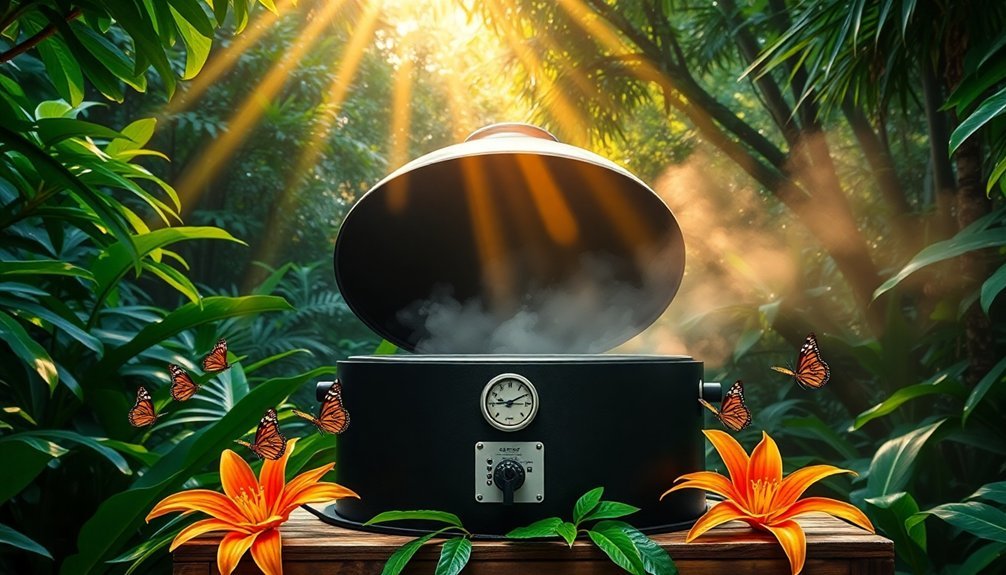
While solar cooking offers an eco-friendly alternative to traditional methods, jungle environments present unique obstacles that you'll need to address.
High humidity and frequent cloud cover can greatly reduce your solar cooker's efficiency by blocking vital sunlight. The dense jungle canopy creates patches of shade that'll limit your cooking spots and time windows. According to data from the Central African Republic, forest cover decreased steadily over two decades, making it crucial to find sustainable cooking solutions.
You'll face the challenge of temperature swings between day and night, which affect your cooker's performance.
Even when you find adequate sunlight, you'll need to reposition your cooker regularly to maintain best exposure. The intense tropical sun requires careful timing and positioning to avoid overheating or underperforming.
Understanding these environmental factors is essential before you invest in a solar cooker, as they'll directly impact your cooking success in jungle conditions.
Best Materials for Humid Conditions
You'll need a well-sealed exterior made from waterproof materials like plastic milk containers or acrylic sheets to protect your solar oven from humidity and unexpected rain.
For the inner components, opt for high-temperature resistant foam and heavy-duty aluminum foil that can withstand both heat and moisture while maintaining efficiency.
Adding vented lids or incorporating breathable insulation helps manage steam buildup without compromising the oven's heating capability. Metal office binder clips provide secure lid attachments for optimal moisture control.
Waterproof Exterior Choices
Three critical components determine the success of your sun oven's waterproof exterior: moisture-resistant coatings, advanced waterproof membranes, and proper drainage systems.
You'll need to select materials that can withstand constant exposure to damp conditions while maintaining their integrity over time.
For maximal protection, apply super hydrophobic coatings, which offer 40% better performance than traditional waterproof materials.
These nature-inspired solutions will make water droplets bounce off your sun oven's surface, similar to how they behave on butterfly wings.
Don't forget to verify proper drainage around your oven to prevent water accumulation.
Install flexible sealants that accommodate material expansion and contraction, but remember they'll need regular inspection and maintenance.
Choose drainage materials that resist corrosion and can handle frequent tropical rainfall. Incorporating anti-microbial materials into your sun oven's design will effectively prevent mold growth in these high-humidity conditions.
Heat-Resistant Inner Components
Building on your waterproof exterior, the inner components of your sun oven must withstand both intense heat and humidity.
You'll want to choose mineral wool for insulation since it outperforms fiberglass when wet and effectively retains heat. Line your oven's interior with black-coated aluminum foil to maximize both heat reflection and absorption.
For thermal mass, incorporate thick, black-coated pots or granite stones to store heat and maintain consistent cooking temperatures.
You'll need a glass or plastic lid to trap heat while allowing sunlight to penetrate. Consider adding a layer of treated bamboo between components, as it's naturally resistant to humid conditions and provides additional insulation.
Remember to create air pockets between layers – these trapped air spaces serve as extra insulation without risking moisture buildup.
Positioning Your Solar Oven
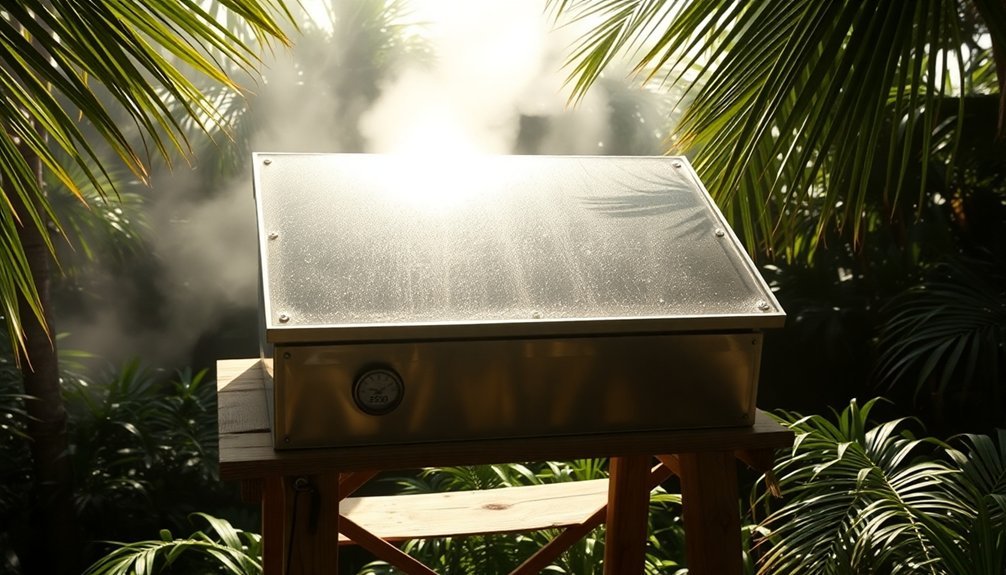
You'll get the best results from your solar oven by placing it on an elevated surface like a table or platform, keeping it well above ground moisture and allowing for better sun exposure.
Make sure there's a clear, unobstructed path between your oven and the sun by checking for and avoiding shadows from nearby trees or structures.
Your oven's placement should consider both the sun's daily path and seasonal changes, allowing you to easily adjust its position throughout the day for maximum sunlight capture.
Elevation For Maximum Exposure
Proper positioning of your sun oven plays an essential role in achieving maximum solar exposure and excellent cooking results.
In humid jungle environments, you'll need to find a spot that's free from canopy cover and other natural obstacles that could cast shadows on your oven throughout the day.
For best performance in tropical settings:
- Choose an elevated location that's above the surrounding vegetation, like a cleared hilltop or raised platform, to minimize atmospheric interference and humidity effects.
- Set up your oven on stable, level ground using a sturdy stand to protect against sudden tropical winds and guarantee consistent heat distribution.
- Position your reflector at an angle that captures the most intense midday sun, typically requiring minimal adjustments near the equator due to the sun's consistent path.
Avoiding Tree Line Shadows
While sun ovens can effectively harness solar energy, tree line shadows pose a significant challenge to their performance, especially in densely forested areas.
To optimize your oven's exposure, you'll need to carefully monitor shadow patterns throughout the day. Position your oven in front of the sun's path, using shadows on its sides for east/west adjustments and the arm shadow for elevation control.
You can use reflective surfaces to redirect sunlight when shadows interfere. If you're in a jungle environment, select a location with minimal tree cover or consider pruning obstructing branches.
Keep your oven mobile and regularly adjust its position as shadows move. Use a sun chart to predict shadow patterns year-round, and plan your cooking times during peak sunlight hours.
Secure your oven against wind displacement using cotton cord when necessary.
Clear Path To Sunlight
Achieving ideal performance with a sun oven depends critically on establishing an unobstructed path to direct sunlight.
You'll need to select a location away from trees, buildings, and other obstacles that could cast shadows throughout the day. For best results, use the E-Z Sun-track indicators on the glass door to align your oven perfectly with the sun's position.
- Position your oven where it'll receive maximum sunlight during peak hours (1-2 PM), and adjust its location every 30 minutes to follow the sun's path.
- Deploy the reflectors fully and secure them with the thumbscrew to capture 40% more solar energy.
- Stabilize your oven using the wind-resistant alignment leg and wire stakes, particularly in breezy conditions, while ensuring the glass door is properly latched.
Heat Retention Tips
Maintaining consistent heat levels in your sun oven requires careful attention to insulation and positioning. You'll want to layer multiple insulating materials like crumpled newspaper and dry leaves around the cooking cavity. Use aluminum foil strategically to reflect heat inward and secure the glazing material tightly to prevent heat escape.
| Action | Benefit |
|---|---|
| Line with dark materials | Maximizes heat absorption |
| Add reflective panels | Directs more sunlight to food |
| Seal with clear wrap | Prevents heat leakage |
Monitor your oven's temperature with a reliable thermometer, aiming for 150-225°F. Choose dark-colored cookware like Corningware or Pyrex, and avoid shiny pots that reflect heat away. Keep the glass door and cooking chamber clean, and remember to preheat for 20-30 minutes before cooking. Reposition your oven every 30-45 minutes to track the sun's movement.
Dealing With Cloud Cover
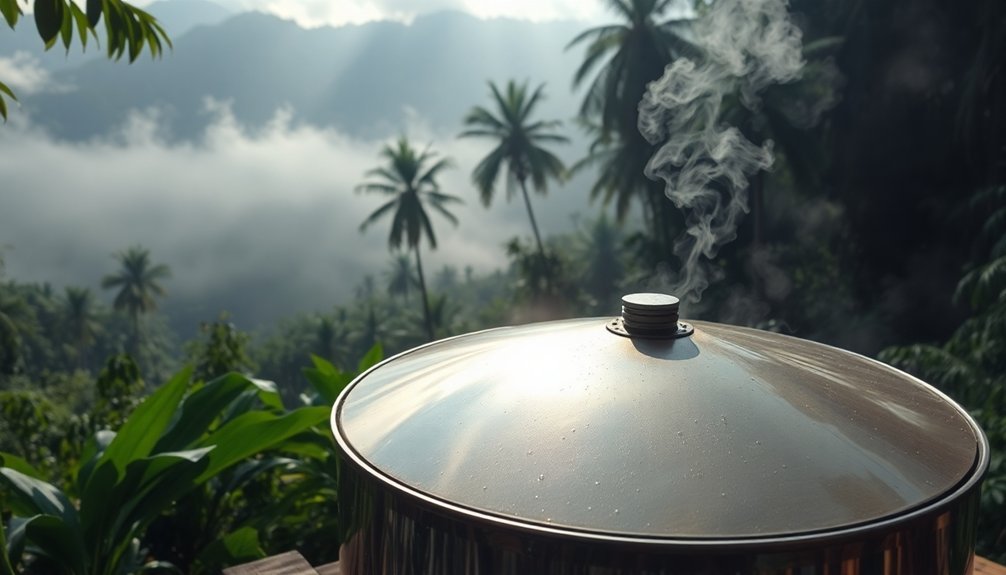
Cloud cover presents one of the biggest challenges when cooking with a solar oven. When clouds block the sun, your oven's temperature can drop from 350°F to just 150°F, greatly impacting cooking times.
You'll need to adapt quickly to maintain effective cooking performance during cloudy periods.
- Position your oven strategically and adjust it every 20-30 minutes to capture maximum sunlight when clouds part.
- Use additional reflective surfaces like aluminum foil to concentrate any available sunlight.
- Enhance insulation to retain heat during cloudy intervals, and consider using a parabolic cooker for better performance.
You can still succeed with your solar oven on partly cloudy days by staying attentive and flexible.
Keep dark, thin metal pots ready, and maintain clear plastic covers to trap precious heat when sunlight becomes available.
Solar Cooking Times
Understanding how long your food will take to cook in a solar oven is essential for successful meal planning.
In humid jungle environments, you'll need to adjust your cooking times to account for higher moisture levels, which can slow down the process. You'll find that quick items like eggs and melted cheese take under an hour, while vegetables and bread need 1-1.5 hours.
Plan 2-2.5 hours for grains and cut-up meats, and 3-7 hours for whole chickens or large cuts.
To optimize your cooking times, use dark cookware to absorb more sunlight, and reposition your oven every 30 minutes to maintain direct exposure.
For best results, cook between 10 am and 4 pm when the sun's rays are strongest. Remember to place your oven in a wind-protected spot to maintain consistent temperatures.
Weather Protection Strategies
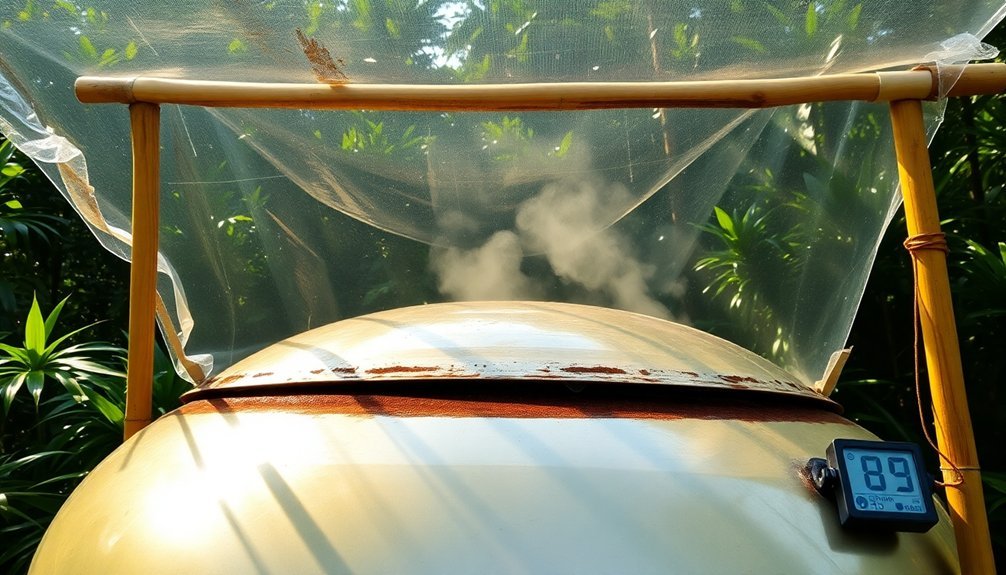
To guarantee your sun oven performs reliably in various conditions, you'll need effective weather protection strategies. Focus on securing your oven against wind by using the T-shaped alignment leg and stakes, which provide stability in winds up to 35 MPH.
In humid environments, verify your cooking chamber remains well-sealed, and keep all reflective surfaces clean and moisture-free.
- Use the E-Z Sun-track indicators to align your oven with the sun every 30 minutes, maximizing heat capture throughout the day.
- Insert wire stakes through the alignment leg base and secure them firmly into the ground when cooking in windy conditions.
- Protect against humidity by performing initial pre-cleaning and maintaining a well-insulated cooking chamber that traps heat effectively.
For peak performance, don't use your sun oven in winds exceeding 35 MPH or during heavy rain.
Maintaining Your Solar Oven
You'll need to regularly clean your solar oven's surfaces with a damp cloth or sponge, paying special attention to the reflective elements that direct sunlight into the cooking chamber.
To prevent rust and extend your oven's lifespan, keep it dry and store it in a covered location away from moisture when not in use.
When cleaning stubborn stains, use a soft-bristled brush with soapy water rather than abrasive materials that could damage the oven's surfaces.
Regular Cleaning Tips
Maintaining a clean solar oven guarantees peak performance and extends its lifespan. In humid jungle environments, you'll need to be extra diligent about cleaning after each use to prevent moisture-related issues and maintain ideal cooking efficiency.
1. After each cooking session, wipe down all surfaces with a soft, damp cloth or sponge to remove dirt and debris.
Don't use abrasive materials that could damage the reflective surfaces or paint.
2. For stubborn stains, use warm soapy water and a soft-bristled brush, paying special attention to the glass door and the area around the black gasket.
3. Clean the reflective surfaces frequently with a soft cloth to maintain their efficiency.
When cleaning in direct sunlight, remember to realign your oven every 30 minutes to guarantee even exposure.
Rust Prevention Methods
Beyond regular cleaning, protecting your solar oven's metal components from rust guarantees long-term durability and maximum performance.
Start by choosing components with rust-resistant finishes like powder coating or anodizing, or opt for corrosion-resistant materials such as stainless steel or aluminum.
Apply rust-inhibiting sprays like Inox MX3FG to vulnerable surfaces, and create a protective barrier through proper seasoning.
You'll want to apply thin layers of flaxseed oil or vegetable oil, then bake them to form a durable coating. Repeat this process 2-3 times for optimal defense.
Position your solar oven in a well-ventilated, elevated area with good drainage to minimize moisture exposure.
Clear surrounding vegetation and guarantee proper airflow.
After each use, apply a light coat of oil and store your oven in a dry place.
Local Recipes for Solar Cooking
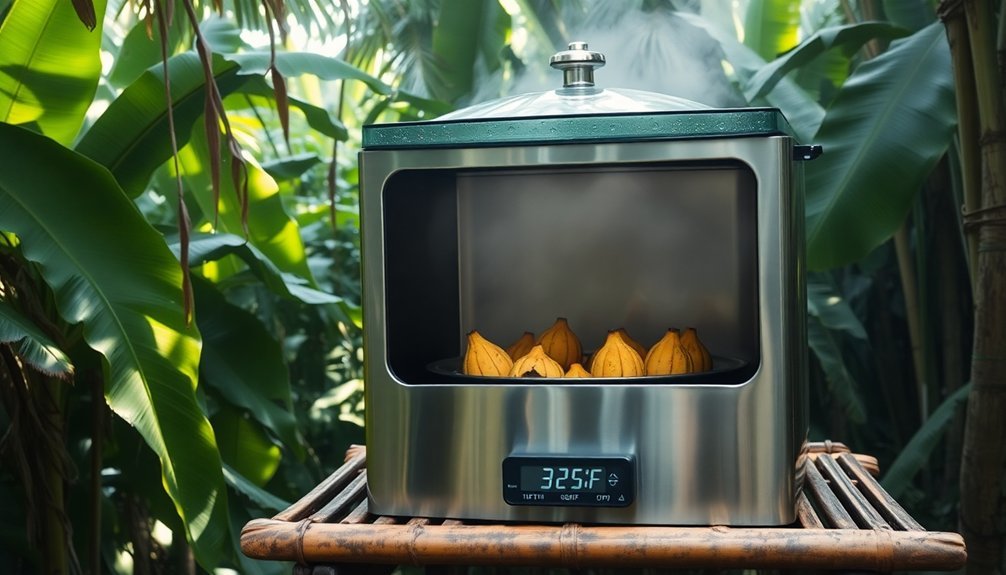
When adapting your solar cooking to local ingredients, you'll discover a world of creative possibilities using fruits, vegetables, and proteins native to your region.
Make the most of tropical ingredients like coconuts, bananas, and root vegetables while incorporating traditional spices such as turmeric and ginger to create flavorful, nutritious meals.
- Try slow-cooking a spicy bean stew with local chilies and coconut milk in your box solar cooker.
- Use your parabolic cooker to grill fresh-caught fish seasoned with herbs and lime.
- Create tropical desserts by baking fruit crisps with mangoes and pineapples topped with coconut.
Remember to adjust cooking times based on available sunlight and always use dark-colored pots to maximize heat absorption.
You'll find that solar cooking enhances the natural flavors of your local ingredients while preserving their nutritional value.
Maximizing Morning Sun Hours
To get the most from your solar cooking journey, understanding how to harness morning sunlight makes a significant difference in your results.
Start your cooking between 9:00 and 10:00 a.m. when the sun's intensity begins to peak. Position your oven facing east to capture the mid-morning rays effectively.
You'll need to plan ahead since solar cooking takes longer than conventional methods. Expect dishes to require 1½ to 3 times more cooking time.
Set up your oven on a level surface and use books or blocks to achieve the ideal angle for sunlight exposure. As the sun moves across the sky, you'll need to adjust your oven's position to maintain direct exposure.
Focus on utilizing the prime cooking hours between 10:00 a.m. and 2:00 p.m. for the best results.
Seasonal Cooking Adaptations
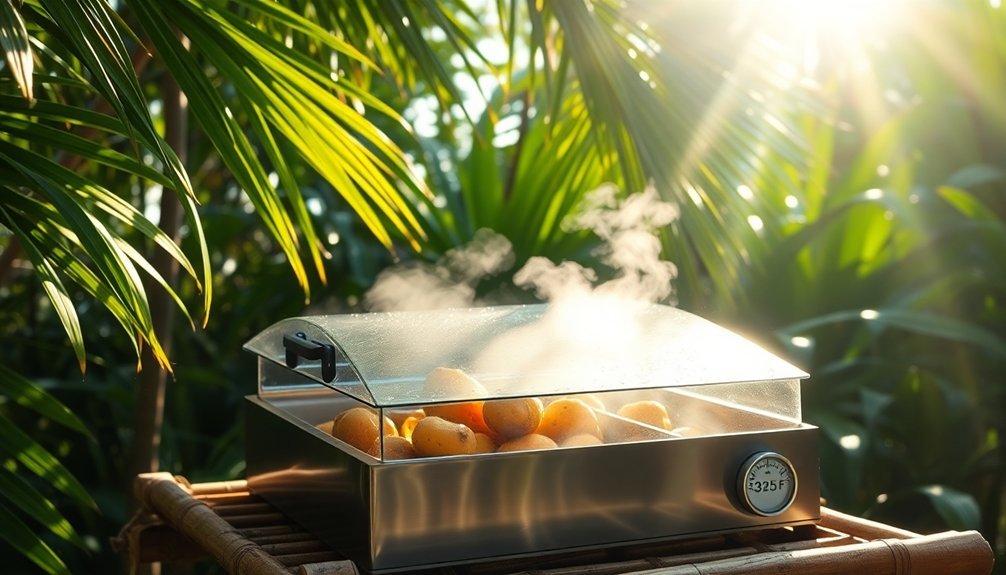
Successful solar cooking requires adapting your techniques as seasons change throughout the year.
You'll need to adjust your sun oven's angle to match the sun's position and account for varying sunlight intensity, which directly affects cooking times. In humid environments, it's essential to manage moisture while maintaining proper heat retention.
- Monitor seasonal cloud cover patterns and use reflectors to maximize sunlight capture during periods of lower sun intensity.
- Protect your food from excess moisture by using lids or baking bags, and reduce liquid quantities in recipes to compensate for humid conditions.
- Double your expected cooking times compared to conventional ovens, and always use a meat thermometer to verify food safety in variable conditions.
Remember to clean your oven regularly and store it in a dry place to prevent mold growth.
Community Success Stories
Looking beyond individual solar cooking techniques, communities worldwide have transformed their lives through sun oven adoption. You'll find inspiring examples in over 100 developing countries where Sun Ovens International's programs have reduced fuelwood usage by up to 70%.
| Location Impact | Community Benefits |
|---|---|
| Rural Villages | Women save 3-4 hours daily on wood gathering |
| Forest Regions | 70% reduction in deforestation pressure |
| Urban Areas | Families save money previously spent on charcoal |
| Remote Communities | Better health from reduced smoke exposure |
The most dramatic changes come from women who've reclaimed their time and safety. Instead of risking dangerous wood-gathering trips, they're now starting small businesses and participating in educational programs. Local economies have strengthened as families redirect fuel expenses toward other needs, while communities enjoy cleaner air and preserved forests.
Innovative Design Features
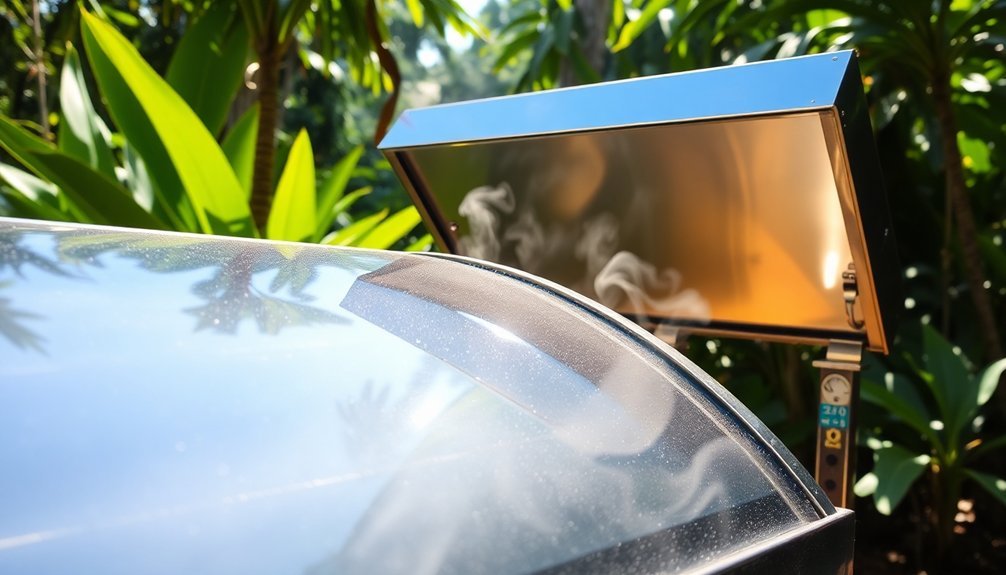
Modern sun ovens incorporate sophisticated design elements that maximize their cooking efficiency and user-friendliness.
With double-glazed glass covers tilted at 15° and rock wool insulation delivering R 6.5 value, you'll achieve superior heat retention even in challenging jungle conditions. The water-resistant insulation, featuring tiny sealed air holes, prevents moisture absorption while maintaining thermal performance.
Key innovative features you'll benefit from:
- High-performance reflective barriers that boost solar capture up to 900 W/m², especially useful in low-light conditions
- Advanced thermal mass system using 5 kg steel plates that reduces temperature fluctuations by 40%
- Dual-position design that adapts to seasonal sun angles, improving efficiency by 12% compared to flat-cover models
The integrated vapor barrier and aerodynamic design guarantee reliable performance in humid, windy environments.
Frequently Asked Questions
Can Solar Ovens Be Used to Pasteurize Drinking Water in Jungle Environments?
Yes, you can effectively pasteurize drinking water using solar ovens in jungles. While humidity and cloud cover may slow the process, you'll still achieve safe drinking water by reaching 150°F with proper insulation and WAPIs.
What Wildlife Precautions Should Be Taken When Using Solar Ovens Outdoors?
Keep your solar oven at least 100 yards from your campsite, as cooking smells attract wildlife. You'll need to clean thoroughly after use and store all food in bear-proof containers or hanging food bags.
How Do Volcanic Ash and Atmospheric Conditions Affect Solar Oven Performance?
You'll notice reduced performance when volcanic ash blocks sunlight and scatters radiation. High humidity causes moisture buildup, while wind increases heat loss. Cloud cover creates temperature drops and longer cooking times.
Can Solar Ovens Help Preserve Excess Fruits During Peak Harvest Seasons?
Yes, you can use solar ovens to dry and preserve excess fruits during harvest seasons. They'll help maintain nutritional value while making your fruits last longer, reducing food waste and providing healthy snacks year-round.
Is It Safe to Leave Solar Ovens Unattended While Cooking?
You shouldn't leave solar ovens unattended during cooking. You'll need to monitor temperatures, adjust positioning every 1-2 hours, and check food doneness regularly to guarantee safety and prevent burning or undercooking.
In Summary
You'll find solar cooking in humid jungles challenging but rewarding when you apply these strategies consistently. Focus on moisture-resistant materials, ideal positioning, and early morning cooking to work around typical afternoon clouds. Don't let high humidity discourage you – with proper ventilation and maintenance, your sun oven can become a reliable cooking method. Join local solar cooking groups to share experiences and continue improving your techniques.
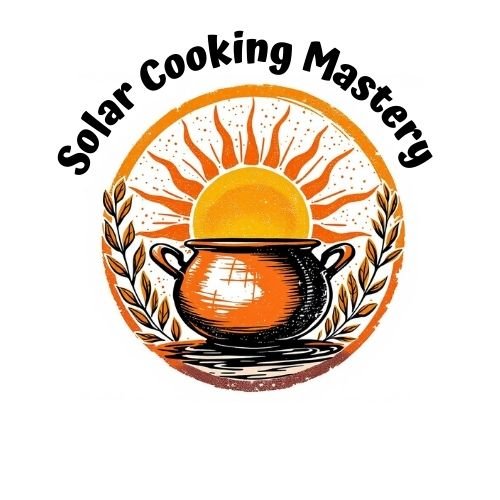

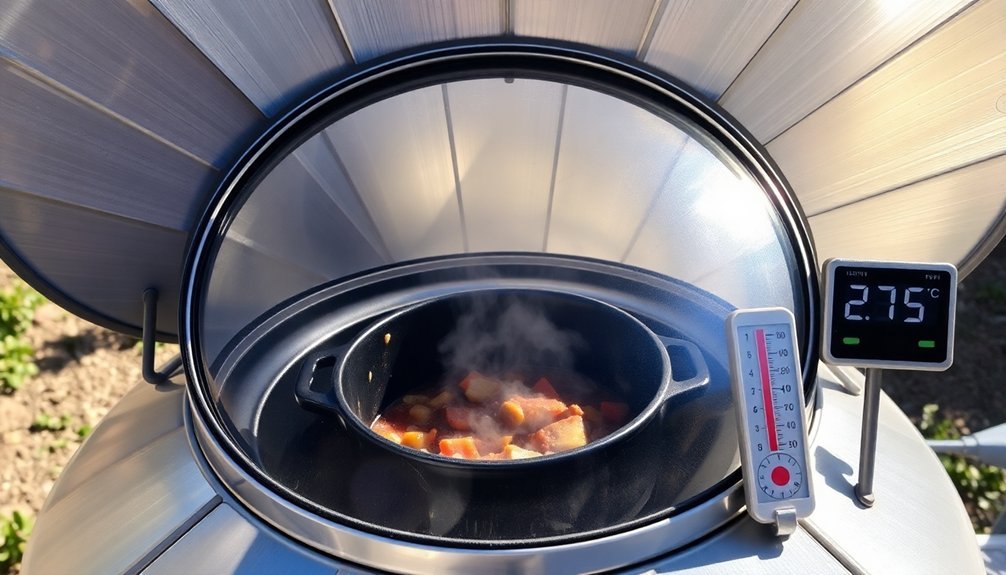
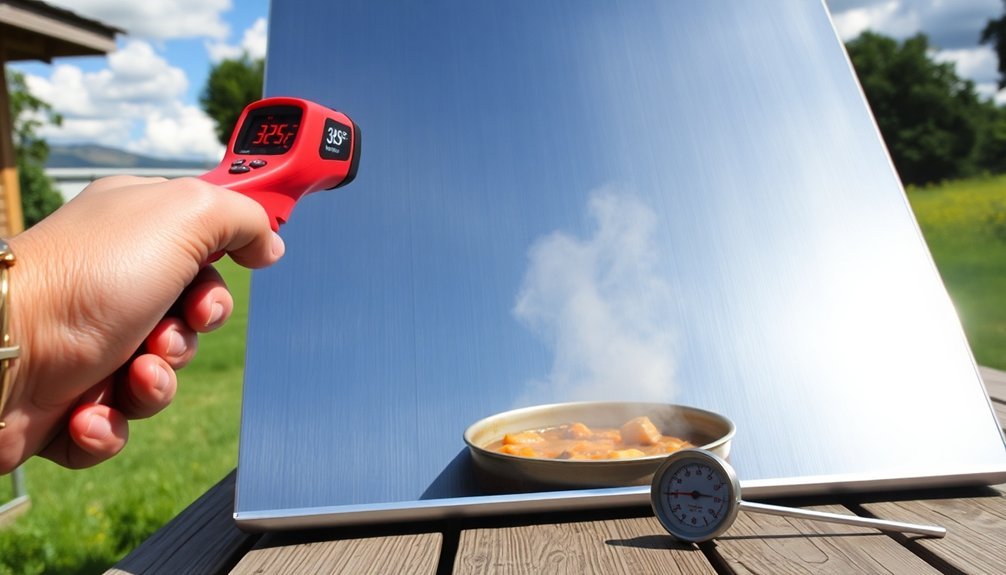
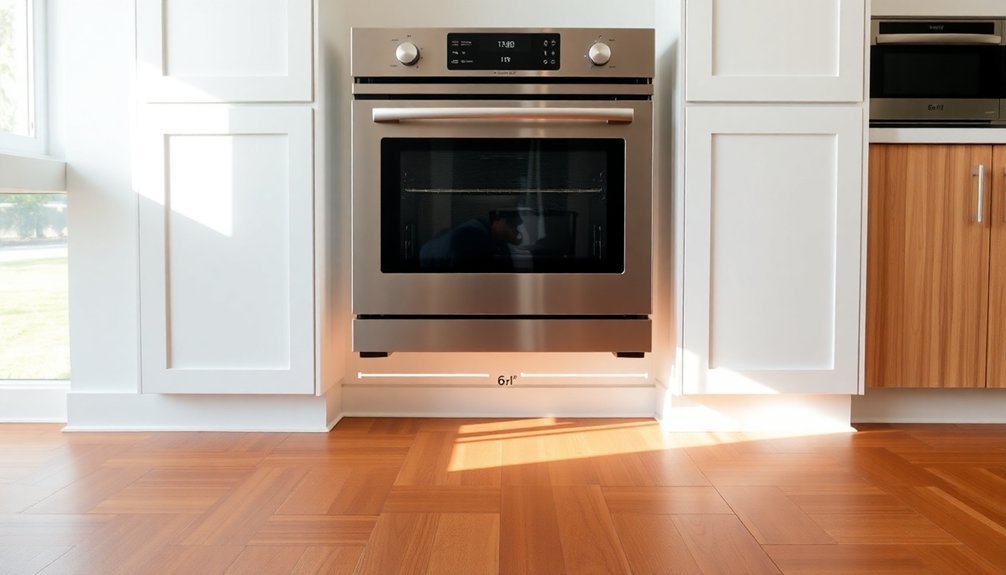
Leave a Reply